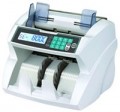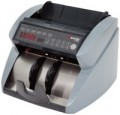Max. counting speed
The highest speed that device is able to count bills (coins in the relevant models, see "Product Type"). Higher speed saves time, but it also affects the price and sometimes the size of the device respectively. Its useful to note that using additional functions (for example, sorting by face), as well as in some other cases (such as dilapidated bills), the actual counting speed may slightly decrease compared to the claimed one.
As for specific figures, speeds
up to 1000 bills per minute are considered relatively low, but they are often quite enough in cases where large amounts are recalculated sporadically and high speed rate is not needed. In most counters (of all types), this indicator lies in the range
from 1000 to 2000 bills per minute, and
higher values found only in certain models of coin counters.
Load Tray capacity
The maximum amount of bills or coins that can fit in the pocket (tray) of the counter; in other words — the largest amount of monetary units that can be counted per one run without reloading (and when reloading money, it is worth considering the capacity of the receiving tray — see below)
Note that this parameter is quite approximate — bills can have different thickness, and furthermore, coins are usually arranged randomly. However, it is still undesirable to exceed the recommendations for capacity in order to avoid overloading the gears.
Authenticity Check
Types of authenticity check with certain signs on the money being counted and provided in the design of the counter. Only models for paper money are equipped with detection (see “Product Type”).
—
By size. A detection that involves determining the size of a bills. In bill counters, usually, it is used for sorting by face (see "Functions") or dilapidation, but it can also be used for other purposes — for example, identifying bills that are not related to the currency being counted.
—
By optical density. Detection based on optical density — the ability of a bills to transmit and retain light. It is mainly used to detect sticky bills and prevent counting errors, but can also be used to screen out worn or suspicious bills.
—
By magnetic marks. Detection based on the reading of magnetic marks. Typically, such marks are applied with a special paint, "noticeable" for magnetic sensors; note that they are widely used in US dollars and euros. This type of detection can be used both to determine the denomination and to separate bills in other currencies and detect counterfeit bills.
—
Ultraviolet (UV). Detection using UV radiation. Devices with this feature are able to detect special security elements that are visible only under ultraviolet light, and respond to the absence or non-standard arrangement of s
...uch elements. Due to this, it is possible to detect not only counterfeit or foreign bills, but also money marked with special compositions (for example, bills used as material evidence in a criminal case on a bribe and signed respectively). However, if the possibility of identifying marked bills is fundamentally important for you, its availability should be clarified additionally.
— Infrared (IR). Detection using infrared radiation. By the operating principle, it is similar to the UV detection described above, however, protective IR elements are less common, and their detection is technically more difficult. Therefore, this detection function is found mainly in hi-end devices, in particular, high-precision sorters (see "Product Type").Features
—
Auto start. Counters with this function can automatically start working when money is in the tray. This get rid of turning on the count manually every time, which saves a lot of time and effort — especially when working with a large amount of bills or coins.
—
Value counting. Possibility of summation of the result of several calculations. This feature is especially useful in cases where all the money that needs to be counted cannot be loaded into the device at one time: you can charge small portions, and the total amount of money will be calculated automatically.
—
Batch feature. In this case, packing means the ability to count a strictly defined number of bills/coins from a stack or pile loaded into the counter. This function is designed mainly for cases where bills/coins are to be packed in packs of a certain quantity (hence the name). At the same time, in some devices you can select any number of bills or coins, in others only a few standard options are available (for example, 10, 20, 50 and 100).
—
Serial number scan. Possibility of reading the serial numbers printed on the bills. The specific usage of this feature may vary. So, some devices are able to compare the numbers printed on different parts of the bills; the discrepancy between these numbers indicates that the bill was glued together from sev
...eral parts. More advanced models are able to compare recognized numbers with a special regularly updated database, which contains counterfeit or potentially counterfeit bills (often they can be identified precisely by the serial number). It may also be possible to write all read bills to the memory of the counter or to an external drive such as a USB flash drive — this can be useful for some specific cash handling tasks.Remote display
Availability of the
remote display bill counter package.
Such a display, usually, duplicates the readings of the main screen installed on the body. The most common way to use this feature is to install a screen in front of the customer, for example, near the checkout window; this allows the client to control the data received by the cashier when counting bills. However, the remote display can also be useful to the operator — for example, if the counter had to be installed in an uncomfortable place where the device's own screen is barely visible.
Power consumption
The power consumed by the counter in regular operation mode. Usually, the regular mode means the counting process with all additional functions; in standby mode the power consumption is significantly less.
In most cases, this spec is relatively small — even high-end models rarely consume more than 400 watts. Therefore, this parameter has practical importance primarily in specific cases — for example, when calculating the load on a voltage stabilizer or an uninterruptible power supply.

